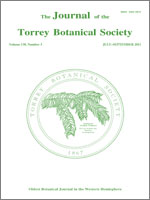Physaria filiformis, a threatened species of calcareous glade communities, blooms profusely within the Rocky Barrens Conservation Area (Missouri) under a program of controlled burns. Flowers visited by insect foragers in 2008 and 2009 had a mean > 35 and > 50 germinating grains on their stigmas respectively and a mean of 1.96–2.0 pollen tubes entering their ovaries (mean of 4 ovules/ovary). Results of controlled hand-pollinations conducted in situ in 2009 showed that this species had a negligible rate of self-pollination (mechanical autogamy) and showed classic Brassica-type, early-acting self-incompatibility. Each dissected flower had nectar glands and each seasonal population was visited by insects representing four insect orders; Coleoptera, Diptera, Lepidoptera and Hymenoptera. The most commonly collected floral foragers found to carry the pollen of the host flower were male and female native bees representing 38 species in the Andrenidae, Apidae, Colletidae, Halictidae, Megachilidae and the naturalized Apis mellifera. Only four of these species (11%) were collected in all three years, but these four accounted for slightly more than a third of all individual bees collected. None of the bees were known specialists on flowers of the Brassicaceae and only two species were habitat (glade) specialists. As P. filiformis is an obligate out-breeder but a generalist entomophile we suggest that future management plans include conservation and management of adjacent non-glade habitats to sustain the diverse range of pollinators.
How to translate text using browser tools
1 July 2011
The Pollination Biology of an Annual Endemic Herb, Physaria filiformis (Brassicaceae), in the Missouri Ozarks Following Controlled Burns
Retha Edens-Meier,
Michael Joseph,
Mike Arduser,
Eric Westhus,
Peter Bernhardt
ACCESS THE FULL ARTICLE
annual herb
glade
native bees
Pollen tubes
self-incompatibility





